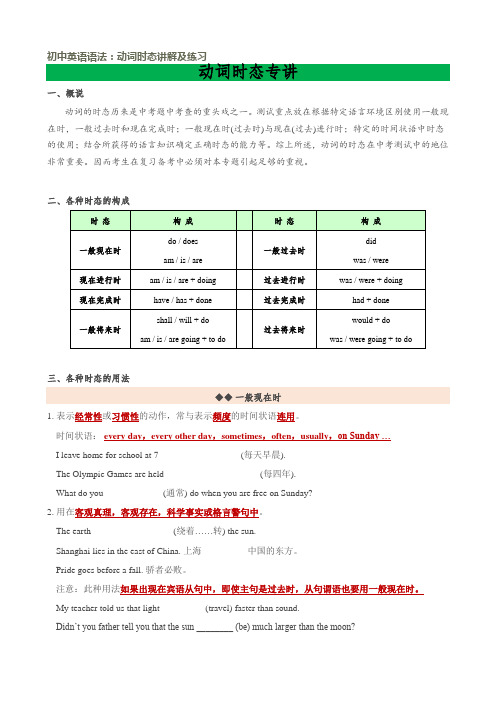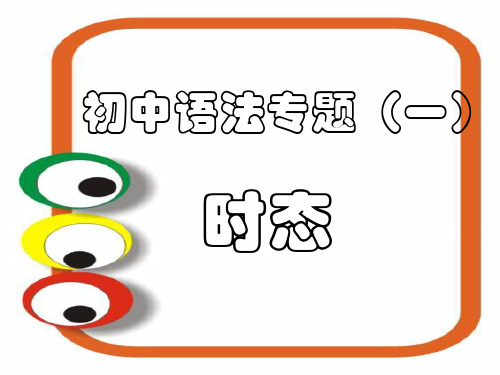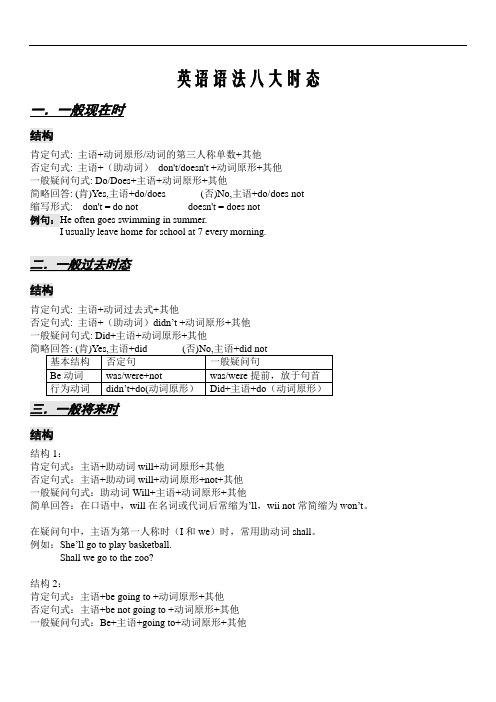初中英语时态用法总结及练习[1]
初中英语语法:动词时态讲解及练习

初中英语语法:动词时态讲解及练习动词时态专讲一、概说动词的时态历来是中考题中考查的重头戏之一。
测试重点放在根据特定语言环境区别使用一般现在时,一般过去时和现在完成时;一般现在时(过去时)与现在(过去)进行时;特定的时间状语中时态的使用;结合所获得的语言知识确定正确时态的能力等。
综上所述,动词的时态在中考测试中的地位非常重要。
因而考生在复习备考中必须对本专题引起足够的重视。
二、各种时态的构成三、各种时态的用法◆◆一般现在时1. 表示经常性或习惯性的动作,常与表示频度的时间状语连用。
时间状语:every day,every other day,sometimes,often,usually,on Sunday …I leave home for school at 7 _________________ (每天早晨).The Olympic Games are held ____________________ (每四年).What do you ____________ (通常) do when you are free on Sunday?2. 用在客观真理,客观存在,科学事实或格言警句中。
The earth _________________ (绕着……转) the sun.Shanghai lies in the east of China. 上海__________中国的东方。
Pride goes before a fall. 骄者必败。
注意:此种用法如果出现在宾语从句中,即使主句是过去时,从句谓语也要用一般现在时。
My teacher told us that light _________ (travel) faster than sound.Didn’t you father tell you that the sun ________ (be) much larger than the moon?3. 表示按计划表或时间表将要发生的动作,某些动词如come, go, move, stop, leave, finish, start等,在一般现在时态中可用来表示将来肯定会发生的动作。
江苏中考英语复习之初中英语主要时态系列(一)—— 一般现在时讲解及练习

一、一般现在时有三种形式1. 谓语是be(am/is/are)的一般现在时。
①肯定形式:主语+be+表语(形容词、名词充当表语)。
I am hungry.You are beautiful.He is a doctor.②否定形式:主语+be+not+表语(形容词、名词充当表语)。
I am not hungry.You aren't beautiful.He isn't a doctor.③一般疑问句形式:Be+主语+表语(形容词、名词充当表语)? 肯定回答:Yes,主语+be. 否定回答:No, 主语+ be+not.—Are you hungry?—Yes,I am./No,I'm not.—Is he a doctor?—Yes, he is./No, he isn,t.④特殊疑问句形式:特殊疑问词+Be开头的一般疑问句?—What is he?—He is a doctor.注意:be要随着主语变。
2. 谓语动词是实义动词(及物动词或不及物动词)的一般现在时。
①肯定形式:“主语+及物动词+宾语”或“主语+不及物动词”。
She has a little brother.她有一个弟弟。
The sun rises in the east.太阳从东方升起。
②否定形式:“主语+don't/doesn't+及物动词+宾语”或“主语+don't/doesn't+不及物动词”。
She doesn't have a little brother.她没有弟弟。
I don't eat every morning.我每天早晨都不吃饭。
③一般疑问句形式:“Do/Does+主语+及物动词原形+宾语”或“Do/Does+主语+不及物动词原形”。
肯定回答:Yes,主语+do/does. 否定回答是:No, 主语+ don't/doesn't.—Do you eat every morning?—Yes, I do./No, I don't.—Does she have a little brother?—Yes, she does./No, she doesn't.④特殊疑问句:特殊疑问词+do/does开头的一般疑问句?What do you like?When do you go to school?注意:根据主语确定用do还是does。
七年级英语时态汇总及练习

七年级英语时态汇总及练习英语时态汇总一般现在时【定义】一般现在时表示现在经常反复发生的动作、存在的状态或惯性的动作。
即描述我们日常生活中的衣食住行等活动。
【用法】(1)在实际应用中,一般现在时常与以下时间状语联用:always,usually,often,sometimes,everyweek(day,year,month,o nceaweek, on Sundays ……例句:XXX.(2)没有时间状语,可以分以下四种类型:A.be型这一类型由be动词+名词、形容词、副词、代词、数词或介词短语等一起构成谓语,表示主语的个性、特征或状态。
如:①I am a student.(主语+be动词+名词)②They are hungry.(主语+be动词+描述词)③He is out.(主语+be动词+副词)④That pen is mine.(主语+be动词+代词)⑤I am fifteen.(主语+be动词+数词)⑥XXX is under the tree.(主语+be动词+介词短语)B.do型do型由行为动词充当谓语,表示经常性或惯性的动作,其构成为“主语+动词原形或动词第三人称单数形式”。
如:①I know XXX.C.there be型there be型句子透露表现“某地存在…”,其组成为“there be+主语+其他”,透露表现客观究竟。
用法遵守“就近准绳”,即主语是单数或并列主语中的第一个主语是单数,则用there is;主语是复数或并列主语中的第一个主语是复数,则用there are。
如:(1)There XXX(主语an eraser是单数)(2)There is an orange,five apples and XXX.(并列主语中的第一个主语an orange是单数)D.情态动词型神态动词型句子的组成为“主语+神态动词+动词真相”,神态动词和动词真相一同组成谓语,透露表现语言人对所叙说的举措或状况的见地。
(word完整版)初中英语时态讲解及练习(含答案),推荐文档

时态1. 一般现在时●形式:do does(单数第三人称)●意义:一般现在时表示客观的、普遍性的真理以及经常性的事件。
●用法:A) 表示现在发生的动作、情况、状态和特征。
B) 经常性、习惯性动作。
e.g.:He always helps others. (他总是帮助别人。
)He often goes to the gym.C) 客观事实和普遍真理。
尤其要注意,如果前后文不是一般现在时,则无法保持主句、从句时态一致。
e.g.: The sun rises in the east and sets in the west.Knowledge is power.●这一用法场合一些表动作频率的时间副词连用:1). 表示肯定的频率副词:always, frequently, usually, sometimes, generally, occasionally, often etc.2). 表示否定的频率副词:never, seldom, rarely etc.➢这些副词的位置:在Be动词后,实义动词前。
e.g. He is always late.2. 一般过去时●形式:did●意义:一般过去时表示在过去的某一特定时间发生和结束的活动或情况。
●用法:A) 表示过去某个时间发生的动作或情况。
e.g.: I saw him in the library yesterday morning. (有特定的时间状语)➢yesterday, yesterday evening, last night/month/spring/year, the night before last(前天晚上),three days/months/years ago, in 1999 etc.。
这些时间状语之前不用加介词。
B) 表示过去习惯性动作,一直持续或反复发生的动作,此时可与表示拼读的时间副词连用。
e.g.: I slept for eight hours last night. (表示在过去某一段时间内持续的动作,但这动作现在已经结束了)3. 一般将来时●形式:will/shall do或be going to do●意义:一般将来时表示在未来的某个时间将要发生的某个动作或状态。
中考英语时态大全 练习(含答案)

知识像烛光,能照亮一个人,也能照亮无数的人。--培根
五、对主语的数判断有误 例: Li Ming with me are (be) in Beijing. 答案: is 解析:表面一看是“我和李明两个人在北京”,但 with 在此做伴随状语,不能做主语,故
用 is. 另外,宾语从句中,从句部分若是表示客观真理,不管主句是何时态,从句都要用一般现
5 / 33
知识像烛光,能照亮一个人,也能照亮无数的人。--培根
二、用动词的正确时态填空 1)I________(talk).You________(listen)tO me now. 2)Look,the boy__________(run)fast. 3)----What are you doing? ----I_________(do) my homework. 4)----_______the students_______(read) English. ----Yes,they are. 5)Tom_______(not study)English.He is studying Chinese. 6)----Who_______(sing)a song? ----Li Ying is. 7)The girl_______(not eat)bananas now. 8)----Where____they____(stand)? ----They are standing over there. 9)Look! The boy over there_______(ply) a model plane. 10)----What is Meimei doing now? ----She______(watch)TV with her parents 11)He____(study) English very hard. 12)We often____(buy)books and things like that in the shop. 13)Polly____(not eat) a banana now.
初中英语时态讲解及练习-(全)

结尾是e的动词在末尾加-d
like→liked live→lived hope→hoped
末尾只有一个辅音字母的重读 plan→planned
闭音节,先双写这个辅音字母,stop→stopped
再加-ed
drop→dropped
结尾是“辅音字母+y”的动词,study→studied
先变“y”为“i”再加-ed
初中语法专题(一)
时态
一般现在时 一般过去时 现在进行时 过去进行时 现在完成时 过去完成时 一般将来时 过去将来时
一般现在时
一、一般现在时:
概念:经常、反复发生的动作或行为及现在的 某种状况。 时间状语: always, usually, often, sometimes, every week (day, year, month…), once a week, on Sundays, etc. 基本结构:①be动词;②行为动词 否定形式:①am/is/are+not;②此时态的谓语动 词若为行为动词,则在其前加don't,如主语为第 三人称单数,则用doesn't,同时还原行为动词。 一般疑问句:①把be动词放于句首;②用助动 词do提问,如主语为第三人称单数,则用does, 同时,还原行为动词。
以辅音字母加y结尾的词 ,先变y为i, 再加-es,读/z/
例子
Play→plays leave→leaves swim→swims
pass →passes fix→fixes teach→teaches wish→wishes do→does
study→studies carry→carries fly→flies
e.g. She will be back in three days. She will not be back in three days. Will She be back in three days? They are going to clean their classroom. They are not going to clean their classroom. Are they going to clean their classroom?
初中英语八大时态用法详解及真题巩固练习

初中英语八大时态用法详解及真题巩固练习一般现在时1. 概念:经常、反复发生的动作或行为及现在的某种状况。
2. 基本结构:①is/am/are;②do/does否定形式:①am/is/are + not ; ②此时态的谓语动词若为行为动词,则在其前加don't,如主语为第三人称单数,则用doesn't,同时还原行为动词。
3. 一般疑问句:①把 is/am/are 动词放于句首;②用助动词do提问,如主语为第三人称单数,则用does,同时,还原行为动词。
4. 用法:1) 经常性或习惯性的动作,常与表示频度的时间状语连用。
例如:I leave home for school at 7 every morning. 每天早上我七点离开家。
2) 客观真理,客观存在,科学事实。
例如:The earth moves around the sun. 地球绕太阳转动。
Shanghai lies in the east of China. 上海位于中国东部。
3) 表示格言或警句。
例如:Pride goes before a fall. 骄者必败。
注意:此用法如果出现在宾语从句中,即使主句是过去时,从句谓语也要用一般现在时。
例如:I knew that the earth goes around the sun when I was little.我小时候就知道地球绕太阳转。
4) 现在时刻的状态、能力、性格、个性。
例如:I don't want so much. 我不要那么多。
Ann writes good English but does not speak well.安英语写得不错,讲的可不行。
5) 一般现在时表示将来含义a. 下列动词 come, go, arrive, leave, start, begin, return 的一般现在时可以表示将来,主要用来表示在时间上已确定或安排好的事情。
初中英语语法八大时态总结及练习题

英语语法八大时态一.一般现在时结构肯定句式: 主语+动词原形/动词的第三人称单数+其他否定句式: 主语+(助动词)don't/doesn't +动词原形+其他一般疑问句式: Do/Does+主语+动词原形+其他简略回答: (肯)Yes,主语+do/does (否)No,主语+do/does not缩写形式: don't = do not doesn't = does not例句:He often goes swimming in summer.I usually leave home for school at 7 every morning.二.一般过去时态结构肯定句式: 主语+动词过去式+其他否定句式: 主语+(助动词)didn’t +动词原形+其他一般疑问句式: Did+主语+动词原形+其他基本结构否定句一般疑问句Be动词was/were+not was/were提前,放于句首行为动词didn’t+do(动词原形)Did+主语+do(动词原形)三.一般将来时结构结构1:肯定句式:主语+助动词will+动词原形+其他否定句式:主语+助动词will+动词原形+not+其他一般疑问句式:助动词Will+主语+动词原形+其他简单回答:在口语中,will在名词或代词后常缩为’ll,wii not常简缩为won’t。
在疑问句中,主语为第一人称时(I和we)时,常用助动词shall。
例如:She’ll go to play basketball.Shall we go to the zoo?结构2:肯定句式:主语+be going to +动词原形+其他否定句式:主语+be not going to +动词原形+其他一般疑问句式:Be+主语+going to+动词原形+其他简略回答:(肯)Yes,主语+be (否)No,主语+be not将来时其他表示法1)be going to表示将来表示说话人的打算、计划、安排或根据迹象判断必然或很可能发生的事情。
- 1、下载文档前请自行甄别文档内容的完整性,平台不提供额外的编辑、内容补充、找答案等附加服务。
- 2、"仅部分预览"的文档,不可在线预览部分如存在完整性等问题,可反馈申请退款(可完整预览的文档不适用该条件!)。
- 3、如文档侵犯您的权益,请联系客服反馈,我们会尽快为您处理(人工客服工作时间:9:00-18:30)。
英语动词时态的用法及练习一般现在时一般现在时基本用法介绍一般现在时的功能:1.表示事物或人物的特征、状态。
如:天空是蓝色的。
___________________ 你是一位学生.______________________2.表示经常性或习惯性的动作。
如:我每天六点起床.___________________________我们每天读英语._________________________________________3.表示客观现实。
如:地球绕着太阳转。
______________________________________一般现在时的构成 1. be动词:主语+be(am,is,are)+其它。
如:我是一个男孩。
_____________________ 这是我的书包。
______________________2.行为动词:主语+行为动词(+其它)。
如:我们学习英语._________________ 我每天步行上学。
______________________________当主语为第三人称单数(he, she, it)时,要在动词后加"-s"或"-es"。
如:玛丽喜欢汉语_______________ 她说英语。
__________________________一般现在时的变化:1. be动词的变化。
否定句:主语+ be + not +其它。
如:他不是工人。
_____________________ 我们不是工人。
______________________一般疑问句:Be +主语+其它。
如:-Are you a student? --- Is Li Ping a teacher?___________________________ ___________________________________特殊疑问句:疑问词+一般疑问句。
如:我的自行车在哪里?Where is my bike ?这是什么?___________________ 你多大________________________________2.行为动词的变化。
否定句:主语+ don't( doesn't ) +动词原形(+其它)。
如:我不喜欢面包。
_______________________ 他们不踢足球。
___________________________当主语为第三人称单数时,要用doesn't构成否定句。
如:他不喜欢汉语。
______________________ 她不踢足球。
_____________________________一般疑问句:Do( Does ) +主语+动词原形+其它。
如:你常常踢足球吗?______________________________ - Yes, I do. / No, I don't.当主语为第三人称单数时,要用does构成一般疑问句。
如:她骑自行车上班吗?__________________________ - Yes, she does. / No, she doesn't.特殊疑问句:疑问词+一般疑问句。
如:你父亲是怎样上班的?_____________________? 他坐公共汽车上班。
_______________动词+s的变化规则1.一般情况下,直接加-s,如:cook-cooks, milk-milks2.以s. x. sh. ch. o结尾,加-es,如:guess-guesses, wash-washes, watch-watches, go-goes3.以“辅音字母+y”结尾,变y为i, 再加-es,如:study-studies一般现在时用法专练:一、写出下列动词的第三人称单数drink________go____________stay____________make__________look________have____________pass__________ carry _________come___________ watch___________ plant_____________ fly ___________study___________ brush____________ do_____________ teach__________二、用括号内动词的适当形式填空。
1. He often ______(have) dinner at home.2.Daniel and Tommy ________(be) in Class One.3.We ___________(not watch) TV on Monday.4. Nick ___________(not go) to the zoo on Sunday.5. ______ they ________(like) the World Cup?6. What _______they often _______(do) on Saturdays?7. _______ your parents _______(read) newspapers every day? 8. The girl _______(teach) us English on Sundays.9. She and I ________(take) a walk together every evening. 10. There ________(be) some water in the bottle.11. Mike _______(like) cooking. 12. They _______(have) the same hobby.13. My aunt _______(look) after her baby carefully. 14. You always _____(do) your homework well.16. She __________(go) to school from Monday to Friday.17. Liu Tao _______(do) not like PE. 18. The child often ____________(watch) TV in the evening.20. -What day ____________(be) it today? -It’s Saturday.三、按照要求改写句子1. I do my homework every day.(改为一般疑问句,作否定回答)___________________________________________2. Amy likes playing computer games.(改为一般疑问句,作否定回答)______________________________________3. We go to school every morning.(改为否定句)__________________________________________________________4. He speaks English very well.(改为否定句)___________________________________________________________5. I like taking photos in the park.(对划线部分提问)______________________________________________________6. John comes from Canada.(对划线部分提问)___________________________________________________________四、改错(划出错误的地方,将正确的写在横线上)1. Is your brother speak English? __________________2. Does he likes going fishing? __________________3. He like playing games after class. __________________4. Mr. Wu teachs us English. __________________5. She don’t do her homework on Sundays. _________________二、现在进行时1.现在进行时表示现在正在进行或发生的动作,也可表示当前一段时间内的活动或现阶段正在进行的动作。
2.现在进行时的肯定句基本结构为:主语+ be(am ,is,are)+ 动词ing + …玲玲正在搬一只箱子。
_______________________. 那些男孩正在骑自行车。
______________3.现在进行时的否定句为:主语+ be(am ,is,are)not + 动词ing + …那些女孩不是在买热狗。
____________________.她不是正在写信。
_____________________4.现在进行时的一般疑问句为:Be(Am ,Is, Are) +主语+ 动词ing + … ?李磊正在做作业吗?_____________________________? Yes,________\ No, ___________.5.现在进行时的特殊疑问的基本结构为:疑问词+ be(am \is\are) +主语+ 动词ing + … ?他正在那边干什么?___________________________?他在找他的书。
__________________但疑问词当主语时其结构为:疑问词+ be + 动词ing + …?谁在房里唱歌?________________________? 是我姐姐。
______________________________动词加ing的变化规则1.一般情况下,直接加ing,如:cook---cooking work---working2.以不发音的e结尾,去e加ing,如:make-making, taste-tasting3.如果末尾是一个元音字母和一个辅音字母,双写末尾的辅音字母,再加ing,如:run-running, stop-stopping 现在进行时专项练习:一、写出下列动词的现在分词:play________run__________swim_________make__________go_________like________write________ski___________ read__________have_________sing______dance_________put_________see________begin________shop___________ buy________ love____________ live_______ take_________ come ________ get_________stop_________ sit ________二.填空:(用现在进行时态完成)1. She ______ __________ (walk) now.2. They ___ _____ (sitt) on the chair.3. Cindy ____ _________ (watch) TV.4. Joe ___ _____ (water) in the garden.5. Look, Nick ____ _____ (come).6. Listen, she ____ _____ ( sing).7. Look, the girl ____ _____ (run). 8.My mother and my father ____ _____ (dance).三.根据汉语意思填空:1.你要去哪儿啊? Where are you _____?2.Nick 正在爬攀登架. Nick ______________ (climb) the jungle gym.3.他们正在读书. They ____________ books now.4. 爷爷正在吸烟. Grandpa _________________(smoke).5.我在做作业. I _______________ (do) my homework.6.我妈妈正在做饭.My mother ______________(cook).7.Jerry在喝柠檬果汁. Jerry ______________ lemon juice. 8.他正在写信. He ________________ a letter.四.填入be动词的适当形式1.He _____ drinking water.2.The eagle _____ flying in the sky.3.Children _____ playing in the playground.4.They _____ working now.5.I _____ going to the supermarket.五、用所给的动词的正确形式填空:1.The boy __________________ ( draw)a picture now.2. Listen .Some girls _______________ ( sing)in the classroom .4. What _____ you ______ ( do ) now?5. Look . They _______________( have) an English lesson .6.They ____________(not ,water) the flowers now. 10.______Helen____________(wash )clothes? Yes ,she is .六、句型转换:1. They are doing housework .(分别改成一般疑问句和否定句)__________________________________________________________________________________________________ 2.The students are cleaning the classroom . ( 改一般疑问句并作肯定和否定回答)_________________________________________________________________________________________________ 3.I’m playing football in the playground .(对划线部分进行提问) _____________________________________________ 4.Tom is reading books in his room. (对划线部分进行提问) _________________________________________________ 七.用动词的适当形式填空(现在进行时与一般现在时对比练习)1.She ______________ (go) to school at eight o’clock.2. It’s six o’clock. They are _____________ supper. (eat)3.He usually _______________ up at 6:00.(get )4. She __________________ (live) in Beijing.5.They are ______________ (dig) a hole (洞).6. My father _______________ (mend) his model(模型) plane these days.九.造句:1).she,the window,open,now.(用现在进行时连词成句.)________________________________2).is,who,the window,cleaning?(连词成句)__________________________________________3).She is closing the door now.(改成否定句)______________________________________4.)You are doing your homework.(用"I"作主语改写句子)_____________________________5).they,the tree,sing,now,under.(用现在进行时连词成句.)__________________________6).The Young Pioneers are helping the old woman.(改成一般疑问句)_________________十、用括号中动词的适当形式填空:1. My parents ____________________(watch)TV now.2. What _______ your mother _______(do)now?3. _______ you _______(listen)to music? Yes, I am.4. Look, Miss Chen __________________ football.(play)5. Tom and his sister ____________(wait)for you over there.6. Now Class 3 and Class 4_________(have)a test.三、一般将来时理论及练习一、概念:表示将要发生的动作或存在的状态及打算、计划或准备做某事。
